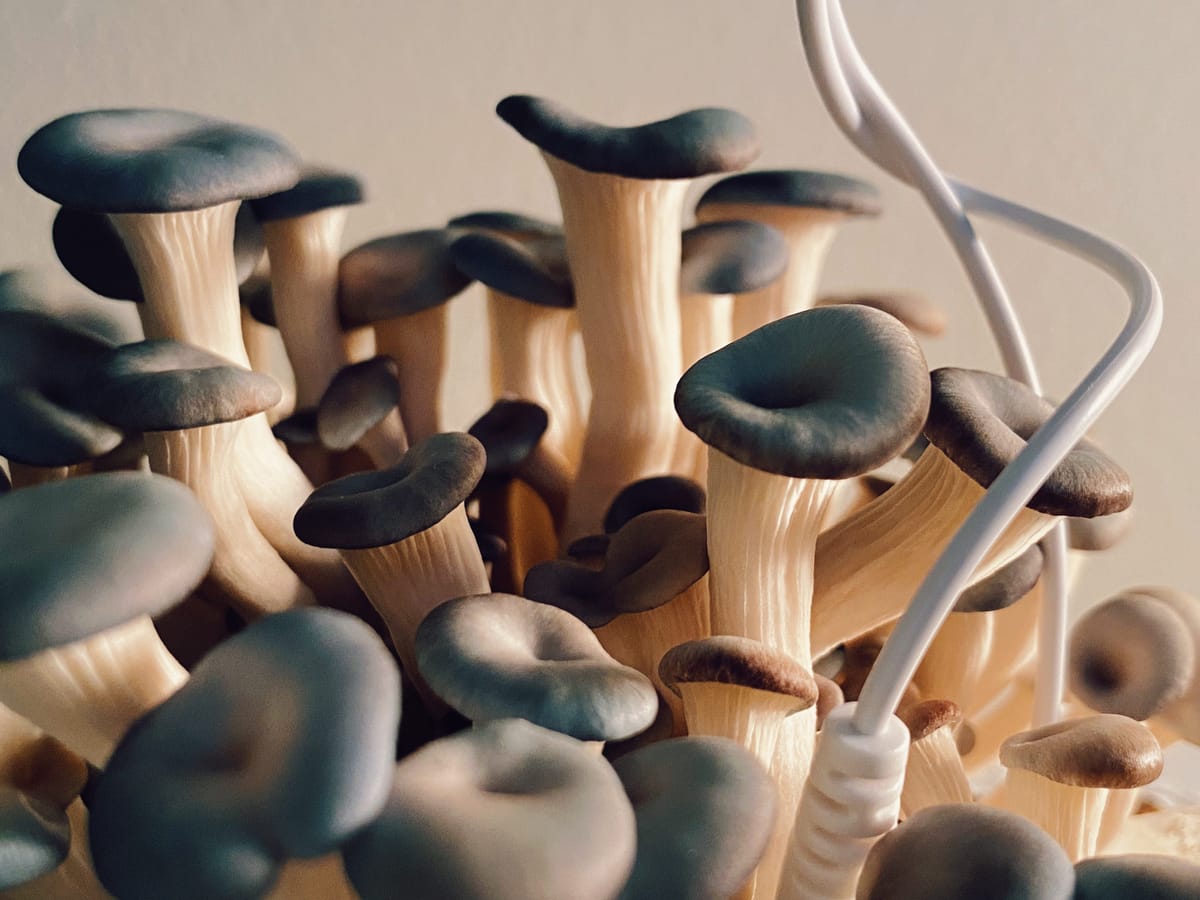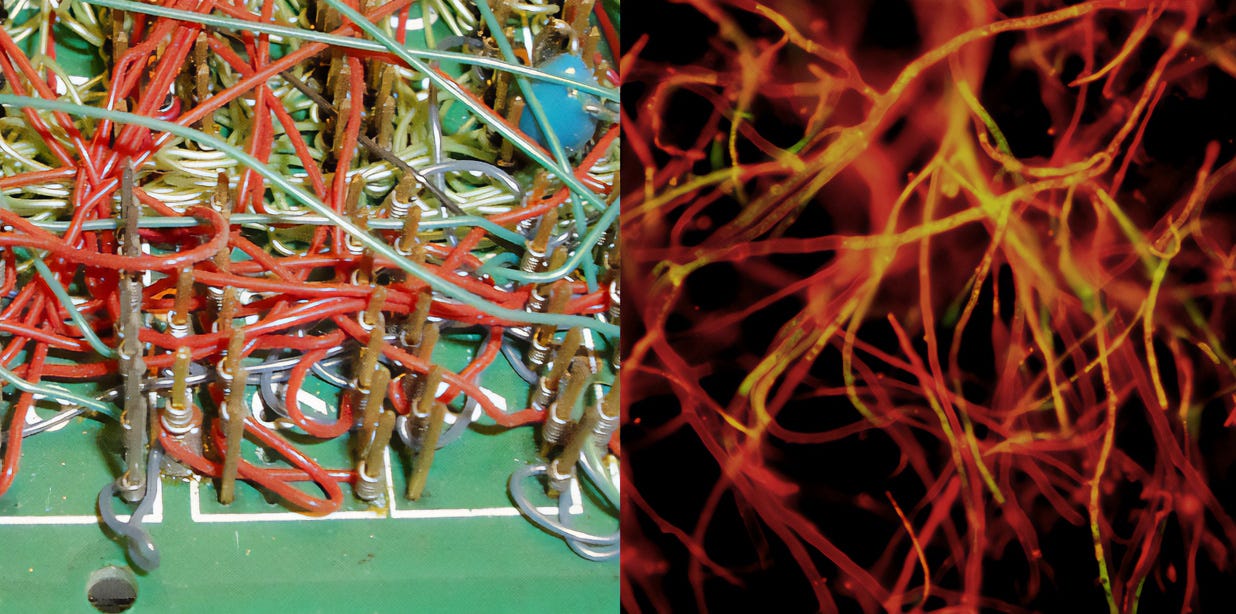Toward Sympoietic Mycomusicology
Get Hyphae

The mushroom sits to my write as I type, emerging from a small bag inside a cardboard box given to us as a thank-you gift for buying basil, mint and lavender seeds. It was a serendipitous give-away, as I was in need of some oyster or shiitake for the purpose of controlling a synthesizer.
The industrial packaging — and placement amongst a series of circuit boards and pale blue, mid-century modern IKEA furniture — betrays the mushroom’s identity as an untamed forest-dweller. But they have done the same thing to me — to us, that is, a species that wanders Target for edible plants rather than scanning what rises from the forest floor.
Wild mushrooms may form rhizomorphs: threads that wind their way beneath the soil, absorbing nutrients before they ever emerge above the surface. Down there, they do all sorts of work, not the least of which is literally transforming death into life. There are mushrooms growing on a dead log in my backyard. There are mushrooms growing, more gruesomely, on the head left behind by a hungry hawk chased off by dog. They are converting — through a loop of secretion, digestion, and excretion — otherwise “dead” materials such as rocks and asphalt into growing bodies.
"A network of growing filaments, called a mycelium, spreads through the soil like the ripples from a stone dropped into a quiet pond. As I sit writing, I can see in the lawn below my fourth-story window a circular patch about six feet across in which the grass has a slightly fresher, greener appearance. I know that the area is underlain by a mushroom mycelium. Last fall the patch was ringed by a perfect circle of mushrooms, what is known as a "fairy ring." Such a ring starts at the center; as the plant's roots deplete the soil of mushroom food, the mushrooms move outward in an ever expanding circle, forming a perfect ring.”
— John Tyler Bonner, from a 1956 Scientific American article "The Growth of Mushrooms" (p. 100).
All this has to be coordinated. And how mushrooms organize the information of their bodies, their networks, is where we meet the circuit board. Andrew Adamatzky, who is researching microbial computers, notes that “there is distant information transfer between fungal fruit bodies,” operating through spiking electrical activity. When certain information conditions are met, the fungal bodies bloom. Caps burst forth. Adamatzky’s initial experiments included saline and heat; electrical information changed in response.
This coordinating activity can be captured and transformed into digital information quite easily. The mushroom may therefore be one of the easiest (and certainly the most edible) of the DIY cyborgs. While the architecture of a mushroom as a computer is quite different, Adamatzky notes, it is nonetheless compatible with the architecture of human-produced information machines, which is no surprise: we have designed computers to count more or less any form of information we ourselves can perceive.
Circuit boards have at least one thing in common with mushrooms, which is that they initially emerged from the surface of dead wood. In 1925, Charles Ducas inscribed the first circuits with conductive ink into the side of a board for slicing bread. We still call these sketch pads for electronic prototyping “bread boards.” With fat fingers, various components for conducting electricity (in both the literal and musical sense) are plugged into place through tiny holes.
Building electronics is, in many ways, building a mushroom in reverse. Emerging from the surface layers of today’s plastic bread boards are resistors and diodes, but we squeeze them into the substrate rather than waiting for them to organically emerge. Nonetheless, the result, when it works, is a conduit for electrical information. As someone who has tried to plug a resistor into the proper leg of an integrated circuit, the bread board is already too small too navigate. But the history of computers is a history of reducing that size further, compressing the fit of conductive surfaces into ever-shrinking spaces. There is no reason circuit boards need to be dense, aside from this desire to save space and material; a sprawling network of conductive wires would function just as well for basic electronic systems.

Is the association between mushrooms and synthesizers a bit of imagining ourselves beneath the substrate? We connect cords to send information from one place to another, just as mycelia sprawls outward, connecting its “sensors” to new soils to see what happens. There’s a visible resemblance between the chaos of patch cords and the limbs of the rhizome. Information flows through both systems using that medium and miracle of electricity.
A synthesizer’s circuitry does not eat, but it would seem, in a surreal sense, to digest. It consumes electricity and information. It’s processed and broken down by a system of circuits which transforms that information and electricity into a signal for a speaker, which emits sonic vibrations. Information becomes sound. That information can be all kinds of things, but not everything, though experimental synthesizer wizards are forever making forays into new forests in search of new ways to move electrical information into sine waves.
Connecting the two is the subject of fascination for a number of artists. I would propose that this has something to do with the issue of control. Literally, plugging the mushrooms in as “control voltage” means that, when you patch a cable into a module, you no longer have manual control over the knob. The electric pulse overrides the living pulse. Your hands stop working: the knob twiddling is now the mushroom’s responsibility, not yours.
These experiments provoke a delightful word, sympoiesis, though maybe not so perfectly. I found this word from M. Beth Dempster via Donna Haraway. Sympoiesis is the term for “collectively-producing systems that do not have self-defined spatial or temporal boundaries. Information and control are distributed among components. The systems are evolutionary and have the potential for surprising change.” Haraway simplifies it further:
Sympoiesis is a simple word; it means “making-with.” Nothing makes itself; nothing is really autopoietic or self-organizing.
She concludes by saying: it is another word for worlding. The population of worlds, shaped by the relationship between its occupants, rather than an assemblage of self-sustained engines.
The entire lifecycle of the mushroom on my desk is “making-with” a synthesizer; it was born capable of generating sound through its electrical current. It’s a sympoietic relationship, and that structure certainly includes me.
Today, all of us are born into the electric grid, but this was not always so. The first human encounter with electricity was likely through the cells of an angry electric catfish, which is capable of stunning a human adult. In the eons since, we have seen the harnessing of electricity tied to all kinds of state and occult powers.
A teenage visit to Times Square left me disoriented amongst the flashing billboards: stunned by the electric catfish of capitalism. Lenin saw electric power as essential to communism; the neon signs towering over Dotonbori in Osaka shows off the capacity of capitalist markets to harvest the same. Stalin and Glico alike sought to steal the power of Zeus, to become gods firing lightning upon us at will. Electric power connects us to the dead in the thoughts of occultists.
Electricity is a medium of communication and control, and therefore, “power.” It has the power to flip a one to a zero, to render us powerless. See it through the Anthropocene — knowledge of the ways humankind is transforming the natural world in irreversible ways — and there is something tempting and romantic about returning control of that power to the natural world. To give mushrooms the power to be heard, even if it falls short of “speech.”
It is satisfying to hear the sound of a mushroom digesting this manufactured world of ours into something nourishing — the body of the mushroom itself, and the music it produces as it grows. It speaks to a balanced order, of nature as a provider of comfort. Brautigan’s cybernetic meadow. It is, perhaps, anti-anthropomorphism, removing the human agent in favor of the agency of nonhuman living beings.
‘Appetite for Deconstruction’ is part of an art-science research project supported by Science Gallery Detroit and in collaboration with Claudia Westermann, Vinny Montag and researchers at the Xi'an Jiaotong-Liverpool University (XJTLU).
In the coming weeks I’ll be using the mushroom-synthesizer project as a lens into pieces of cybernetics and ecosystems. I’ll also stray from mushrooms and synthesizers now and then! If you can think of someone who might be interested please encourage folks to sign up, and as always, you can share these newsletters freely using the link below. I’m always on Twitter as @e_salvaggio.





